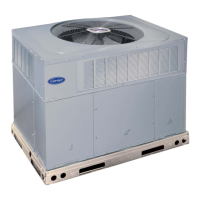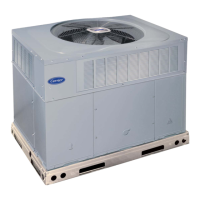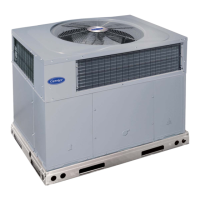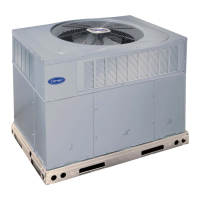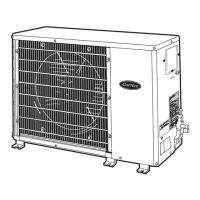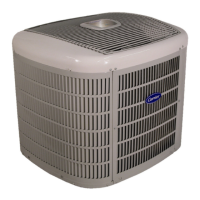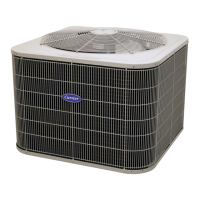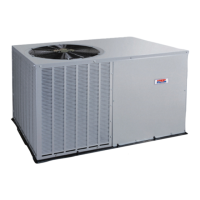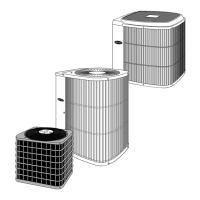50VR-K: Installation Instructions
Manufacturer reserves the right to change, at any time, specifications and designs without notice and without obligations.
12
Pre-Start-up
Use the Start-Up Checklist supplied at the end of this book and proceed
as follows to inspect and prepare the unit for initial start-up:
1. Remove all access panels (see Fig. 22).
2. Read and follow instructions on all DANGER, WARNING,
CAUTION, and INFORMATION labels attached to, or shipped
with unit.
3. Make the following inspections:
a. Inspect for shipping and handling damages, such as broken lines,
loose parts, disconnected wires, etc.
b. Inspect for oil at all refrigerant tubing connections and on unit
base. Detecting oil generally indicates a refrigerant leak. Leak
test all refrigerant tubing connections using electronic leak
detector, or liquid-soap solution. If a refrigerant leak is detected,
see following Check for Refrigerant Leaks section.
c. Inspect all field- and factory-wiring connections. Be sure that
connections are completed and tight. Ensure wires do not touch
refrigerant tubing or sharp sheet metal edges.
d. Inspect coil fins. If damaged during shipping and handling,
carefully straighten fins with a fin comb.
4. Verify the following conditions:
a. Make sure that outdoor-fan blade is correctly positioned in fan
orifice.
b. Make sure that air filter(s) is in place.
c. Make sure that condensate drain pan and trap are filled with
water to ensure proper drainage.
d. Make sure that all tools and miscellaneous loose parts have been
removed
5. Each unit system has two (2) Schrader-type ports, one low-side
Schrader fitting located on the suction line, and one high-side
Schrader fitting located on the compressor discharge line. Be sure
that caps on the ports are tight.
Start-up
Step 1 – Check Cooling and Heating Control Operation
Start and check the unit for proper control operation as follows:
1. Place room thermostat SYSTEM switch or MODE control in OFF
position. Observe that blower motor starts when FAN mode is
placed in FAN ON position and shuts down when FAN MODE
switch is placed in AUTO position.
2. Thermostat:
On a typical two stage thermostat, when the room temperature rises
1 or 2 degrees above the cooling control setting of the thermostat,
the thermostat completes the circuit between thermostat terminal R
and terminals Y1, and G. These completed circuits through the
thermostat connect the contactor coil (C) (through unit wire Y1)
and indoor fan board (through unit wire G) across the 24-v.
secondary of transformer (TRAN).
On a typical two stage thermostat, when the room temperature is
several degrees above the cooling control setting of the thermostat,
the thermostat completes the circuit between terminal R and
terminals Y1, Y2, and G.
3. If your unit contains accessory electric heat, place system switch or
MODE control in HEAT position. Set control above room
temperature. Observe that the indoor blower is operating and warm
air is flowing through the supply air vents inside your home.
Observe that the heating cycle shuts down when the control setting
is satisfied.
If your unit does not contain accessory electric heat and you would
like to obtain it, please contact your local dealer for more
information.
4. When using an automatic changeover room thermostat place both
SYSTEM or MODE control and FAN mode stitches in AUTO
positions. Observe that unit operates in Cooling mode when
temperature control is set to “call for Cooling” (below room
temperature).
NOTE: Once the compressor has started and then has stopped, it should
not be started again until 5 minutes have elapsed.
Step 2 – Check for Refrigerant Leaks
Proceed as follows to locate and repair a refrigerant leak and to charge
the unit:
1. Locate leak and make sure that refrigerant system pressure has been
relieved and reclaimed from both high-and low-pressure ports.
2. Repair leak following Refrigerant Service procedures.
NOTE: Install a filter drier whenever the system has been opened for
repair.
3. Add a small charge of R-410A refrigerant vapor to system and
leak-test unit.
4. Recover refrigerant from refrigerant system and evacuate to 500
microns if no additional leaks are found.
5. Charge unit with R-410A refrigerant, using an electronic scale.
Refer to unit rating plate for required charge.
Step 3 – Start-Up Adjustments
Complete the required procedures given in the Pre-Start-Up section
before starting the unit. Do not jumper any safety devices when
operating the unit. Do not operate the unit in cooling mode when the
WARNING
!
ENVIRONMENTAL, FIRE, EXPLOSION, ELECTRICAL
SHOCK HAZARD
Failure to follow this warning could result in personal injury or death
and/or property damage.
1. Follow recognized safety practices and wear protective goggles
when checking or servicing refrigerant system.
2. Relieve and recover all refrigerant from system before touching or
disturbing compressor plug if refrigerant leak is suspected around
compressor terminals.
3. Never attempt to repair soldered connection while refrigerant
system is under pressure.
4. Do not use torch to remove any component. System contains oil
and refrigerant under pressure.
5. To remove a component, wear protective goggles and proceed as
follows:
a. Shut off electrical power to unit and install lockout tag.
b. Relieve and reclaim all refrigerant from system using both high-
and low-pressure ports.
c. Cut component connecting tubing with tubing cutter and
remove component from unit.
d. Carefully unsweat remaining tubing stubs when necessary. Oil
can ignite when exposed to torch flame.
WARNING
!
EXPLOSION HAZARD
Failure to follow this warning could result in
death, serious personal injury, and/or property
damage.
Never use air or gases containing oxygen for leak
testing or operating refrigerant compressors.
Pressurized mixtures of air or gases containing
oxygen can lead to an explosion.
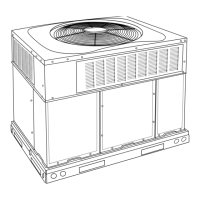
